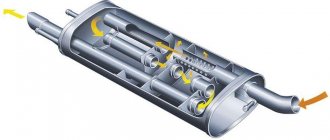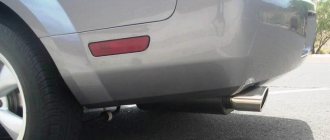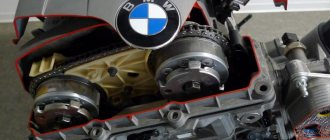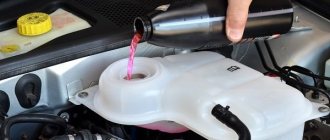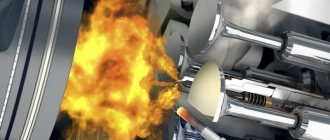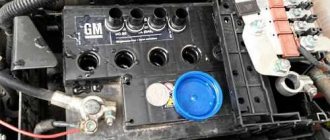The principle of operation of a car exhaust system
Timely and high-quality removal of exhaust gases plays a big role. Because if exhaust gases are not removed in time, they will remain in the combustion chambers of the cylinders and fill a certain volume, which means this will lead to loss of engine power and unstable operation.
The exhaust system consists of several sections connected to each other by mounting bolts.
Purpose of all sections:
- removal of all exhaust gases from the combustion chambers of the engine cylinders;
- reducing the noise of the power unit (engine) during operation;
- reducing the level of toxicity in exhaust gases;
- preventing exhaust gases from entering the vehicle interior.
The simple design of the exhaust system removes gases through pipes. Everyone probably knows that if a muffler or muffler pipe gets a hole, the noise of the engine increases several times.
The toxicity level is reduced by installing catalysts in the exhaust system. The operation of the catalyst is monitored by a lambda probe. Diesel units use a particulate filter to reduce emissions of harmful substances.
Some people remove this sensor themselves and install a false lambda probe.
Both gasoline and modern diesel internal combustion engines use a turbocharger, which forces a mixture of oxygen and exhaust gases, which it sucks from the exhaust manifold. A sensor is installed on the exhaust manifold housing of such machines, which regulates the supply of exhaust gases to the turbine.
Causes of muffler failure:
- High temperature conditions inside the system, about 600 °C. Temperature promotes metal burning;
- As a result of active exposure to the external environment (water, dirt, temperature changes);
Exhaust fumes and road surfaces are two of the exhaust pipe's worst enemies.
- The main enemy of a car muffler is low quality fuel, which contains many different impurities. This contributes not only to rapid burnout, but also to contamination of the catalyst, which cleans the exhaust gases of impurities.
- Incorrectly configured ignition system parameters (high CO content).
Car exhaust system design
The structure of the exhaust system of modern cars includes about 5 elements, each of which performs its own function. The exhaust system diagram includes:
- An exhaust manifold.
- Exhaust gas exhaust pipe, also known as “pants”.
- Catalytic converter or catalyst.
- Flame arrestor or resonator.
- Muffler.
An exhaust manifold
The exhaust manifold is used to receive exhaust gases from the combustion chambers of the cylinders. Material: cast iron or stainless steel, or ceramics.
Downpipe
The exhaust pipe, which is usually called the pants, serves to combine exhaust gases coming from different cylinders into one common manifold. The exhaust gas mixture then passes through the catalyst. In this area, corrugation is often installed to dampen vibrations, which are transmitted to the exhaust system structure by the engine through a rigid connection.
Catalyst or catalytic neutralizer
The catalyst resembles a ceramic honeycomb. The catalyst is coated on top with an alloy of iridium and platinum. Such substances allow them to enter into a chemical reaction with substances contained in exhaust gases. Here the separation into oxygen and nitric oxide occurs. The separated pure oxygen helps burn the remaining fuel-air mixture, resulting in a nitrogen-carbon dioxide mixture being supplied to the muffler. The lambda sensor probe transmits catalyst operation data to the control unit (ECU). A similar sensor is installed on the exhaust manifold to analyze the toxicity of gases that enter the catalyst.
Resonator or flame arrester
This device serves to reduce the temperature of the exhaust gases. The temperature decrease occurs due to the cellular structure.
Muffler
The final section of the exhaust gas outlet is the muffler. Its body contains a perforated pipe (that is, a pipe with holes), the task of which is to reduce noise.
All sections are connected to each other by bolts through flanges. The connections between the parts must be airtight, so heat-resistant seals are installed.
Aspects of muffler selection
But how to choose a muffler and what do you need to remember? The price of the device depends on its volume, materials and design. And when choosing, you should pay attention to the following:
- Appearance and design – it is visually easy to determine the format of the muffler. And the presence of paint indicates the type of metal. Aluminized steel is not painted;
- Weight – the heavier the product, the better quality it is;
- Assembly – if, even with a quick inspection, steel folds are visible on the base, then it is better to refuse to purchase such a muffler.
Other factors also influence the choice of muffler. We are talking about the quality of perforated pipes, a two-layer base, and so on. Direct-flow mufflers are considered optimal. But they affect the power of the internal combustion engine. Products made of aluminized or stainless steel are more preferable.
Selection methods
If there are often no problems with the question of which muffler to choose, then the search method causes difficulties. But there is no need to worry. You can select a part as follows:
- By VIN code is a simple and hassle-free search method. But it may not work on a number of resources;
- According to the technical parameters of the vehicle, you need to indicate the make and model of the car, and also follow the tree structure to the muffler. After this, all suitable options will be displayed;
- A universal model - such a muffler is inexpensive, but its quality is not the highest. Although in some cases such a purchase is the only solution to the problem.
You can use a muffler from another car. But buying used components comes with certain risks. And their service life is impossible to predict.
Brands and features of their products
But which muffler brand should you choose and which brand should you trust? There are various brands of products on the market, but the following manufacturers deserve the most trust:
- Atiho (Russia);
- Polmostrow (Poland);
- Bosal (Belgium);
- Walker (Sweden);
- Asso (Italy).
European companies hold the leadership. Particularly notable products are Bosal and Walker, which are characterized by practicality and durability. Domestic analogues have a more affordable price tag and corresponding quality. The Polish company Polmostrow also offers high-quality products in a fairly wide range. But it is better to refuse to buy Italian mufflers. Their geometry is incorrect, and this entails installation difficulties.
Counterfeits and their detection
And one more aspect. You can choose a muffler by studying brands, but you should also remember about fakes. Moreover, they can be identified at the acquisition stage. You just need to pay attention to the following:
- The thickness of the metal - a thin and fragile base directly indicates the low quality of the product;
- Data on the packaging - the absence of identification data and branding marks is evidence of counterfeiting;
- Muffler reservoir - visually the fake looks much smaller than the original counterpart;
- Paint - low quality paint complements the overall picture and directly indicates a fake.
The price aspect is also important. After all, a branded part cannot have a low price tag. And the place of purchase is worth considering. It is unlikely that you will come across a fake in a store. But there are plenty of similar products on the market.
Types of malfunctions and repairs of the car exhaust system
Many car enthusiasts will improve their exhaust system. This is done mainly by young people who love tuning their cars. One of the options for such tuning is to remove the resonator and install a direct-flow exhaust.
The main malfunction of the exhaust system is leaky connections, due to which, for example, exhaust gases enter the cabin when the doors are opened. Eliminated by purchasing and installing a repair kit for connecting parts of the exhaust system.
Also, due to high temperatures and aggressive environments, the metal quickly rusts. The pipe becomes unusable.
If the pipe has a hole, it will be immediately obvious by the high noise level. The noise will be like a go-kart.
It is prohibited to operate a vehicle without an exhaust system. This is both dangerous and will destroy the engine.
What is a car muffler
A muffler is a volumetric flask installed at the end of the exhaust system. It is installed to dampen sound waves generated during engine operation. This is an integral part of the entire exhaust system of a car.
In addition, before exhaust gases are released into the environment, they must be cooled. This is another function of this part. Today there is a wide variety of mufflers that differ from each other not only in their efficiency, but also in design.
Material and manufacturing method
Before you make a muffler with your own hands, you need to decide on the budget and the option for reworking the exhaust system. There are several tuning methods:
- Modification of a new factory muffler.
- Making your own. By the way, you can make a muffler with your own hands using both stainless steel and ordinary steel.
Experts do not recommend using old mufflers or other parts of the exhaust system that have already been used. In this case, even if they look good (after all, they can be repainted before selling), the inside will be covered with corrosion or even burnt out. Remember that with each engine start, the metal in the system heats up and changes its properties. It’s easy to guess what condition a muffler will be in if it’s been used for about 2-3 years on a car. Therefore, do not fall for the tricks of “lightly used” sellers and do not buy a used muffler. Best of all, make it yourself.
A less expensive solution from a financial point of view would be tuning the standard muffler. Making a part with your own hands from stainless steel is a very reliable, but expensive option. However, such an element will be more durable and will not burn out at the most inopportune moment.
What is a flute in a direct-flow muffler, and what is its effect?
To make the forward flow quieter and get “passing” decibels at the output, a simple design is used, which motorists call a flute. This is a piece of perforated tube with a length of 180–250 mm and a diameter of slightly more than 1/3 of the exhaust, with a welded plug washer in the form of a disk, cylinder or cone, which is bolted inside the forward flow, at the air cut, thereby allowing it to be muffled.
The principle of operation of the flute for direct flow is that when the cross-section of the exhaust channel changes and exhaust gases exit through the perforations, the following occurs:
- change in speed and pressure;
- the sound wave breaks;
- the volume decreases by 3-4 dB, the exhaust becomes quieter.
The correct name for this flute is silencer (from the English silencer - muffler), and it is included in the set of expensive exhaust systems that are sold on the Internet. You can also purchase separately, the average price of good European models is 70–150 dollars, and mass ones from the Middle Kingdom - from 450 rubles.
FEATURES OF THE FORWARD FLOW SILENCER
Such a device can be used to increase the power output of a car. A straight-through muffler uses the energy of gas flows, which is converted into vehicle power.
No matter how strange it may sound, this is possible: first, gas flows are released from the manifold with minimal resistance, and the car engine, in turn, expends less effort to overcome the force of their pressure. This is what achieves an increase in the useful power of the car engine.
When making a direct-flow muffler, a chamber is used, inside of which a perforated pipe is placed, and there is also a small number of dividing partitions (when making a direct-flow muffler with your own hands, this important detail must be taken into account).
The exhaust gases experience virtually no resistance from the internal partitions, and the holes in the pipe allow them to expand as much as possible, after which they exit almost silently. This is also facilitated by the use of external casings impregnated with a special composition.
Exhaust system and care
Signs of a faulty exhaust system:
- if while driving the car it is accompanied by a loud roar;
- vehicle fuel consumption increases sharply;
- unstable operation of the car appears;
- there is a constant loss of power;
- soot forms on all parts;
- The car's cooling system stops coping with cooling due to the increased temperature of fuel combustion.
All of the above signs confirm that the exhaust system is faulty. As a result, the process of exceeding the limit readings of the backpressure occurs. Therefore, your car needs exhaust system repair.
Most often, these consequences are caused by mechanical damage to the components. The stable operation of the car can be affected by a violation or discrepancy between the diameter of the exhaust pipe and that recommended by the manufacturer.
Backpressure in a car exhaust system can be the result of the gas pipeline being made with many sharp bends, or it being welded from separate segments (each weld gives more resistance).
Car owners should not forget that rust negatively affects the metal parts of the car.
To avoid corrosion, you need to know the design of the exhaust system of your car. What metal is it made of, rust-proof or stainless? Do not allow water to enter the exhaust gas system, especially into the resonator and muffler. Otherwise, condensation and various chemical active compounds, reagents and salts will begin to accumulate here. Sudden changes in temperature should be avoided; it is especially dangerous when these changes occur frequently.
Timely prevention and repair of the exhaust system will help save your nerves and finances. If you have the slightest suspicion of a system malfunction, immediately contact a service station.
And here is a video that demonstrates how, by tuning the exhaust system, you can increase the engine power of a car from Germany Porsche by 15%:
Muffler design for VAZ 2101/2107/2109/2110/2015
Despite the fact that the principle of operation of all VAZ muffler classics and later models is the same, they still have design distinctive features.
For example, consider the muffler design on a VAZ 2101.
The product has three cameras, the general structure is presented below:
- Upper half-body;
- Thermal insulation;
- casing;
- Partitions of the right and left chambers;
- Inlet pipe;
- Front partition;
- Perforated exhaust pipe;
- Perforated pipe internal;
- Perforated intake pipe casing;
- Rear partition;
- Semi-hull lower;
- Exhaust pipe;
- Front exhaust pipe;
- Main muffler;
- Suspension strap;
- Pillow suspension;
- Grazing pipe.
Muffler design of late models using the example of a VAZ 2110.
- Reception pipe;
- Bracket;
- Clamps;
- Resonator;
- Suspension cushions;
- Main muffler;
- Exhaust pipe;
- Perforated rear resonator tube;
- Posterior partition;
- Front partition;
- Perforated front resonator tube;
- Frame;
- Front perforated pipe;
- Inlet pipe;
- Outlet pipe;
- Frame;
- Posterior partition;
- Middle partition;
- Rear perforated pipe;
- Front partition.
"Izhora muffler" 135884
Price: 994 rubles
By design, the muffler is a simple three-chamber reactive type muffler. Accordion folds formed in the places where the pipes were bent. The soft side hook fastening is welded to the wall of the can on only one side - there is a high risk that it will be deformed during transportation. There are some stuck welding splashes on the surface of the can.
